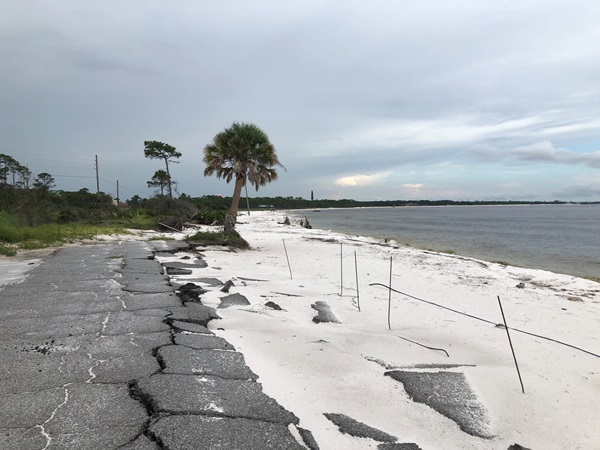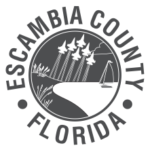On Sept. 23, the U.S. Department of Defense Office of Local Defense Community Cooperation announced the award of $6.4 million to Escambia County to partially fund the construction of the Pensacola Bay Living Shoreline Project. This was one of only 13 projects awarded in the national Defense Community Infrastructure Program funding opportunity.
The DoD award will fund construction of a large-scale living shoreline at Sherman Inlet, located offshore of Naval Air Station Pensacola, by creating a series of emergent and submerged breakwaters across 5,300 linear feet of shoreline. Once complete, the living shoreline will greatly enhance the coastal resilience of NAS Pensacola. The shoreline at Sherman Inlet has experienced significant erosion due to frequent storm events and wave energy generated through Pensacola Pass, creating an enhanced risk to installation infrastructure and mission readiness.
“The recent approval of the Defense Community Infrastructure Program grant is another great example of the community partnership between NAS Pensacola and Escambia County," said Captain Tim Kinsella, Commanding Officer, Naval Air Station Pensacola. "The Living Shoreline Project will provide lasting contributions to the health of the Pensacola Bay and is significant to the coastal resiliency of NAS Pensacola.”
This award builds on two additional grants received earlier this year to fund construction of the project. The National Fish and Wildlife Foundation (NFWF) awarded $2.5 million from the National Coastal Resilience Fund to support construction of the Sherman Inlet living shoreline in addition to a $9 million NFWF Gulf Environmental Benefit Fund award to fully construct a living shoreline and restoration at White Island.
“Escambia County is incredibly grateful to the Department of Defense Office of Local Community Cooperation for investing in this green infrastructure project to strengthen the resilience of NAS Pensacola while improving aquatic habitat surrounding the installation," said Matt Posner, Escambia County RESTORE Program Manager. "NAS Pensacola has been a great partner and we look forward to working with them through construction to ensure they can implement their mission well into the future.”
About the Pensacola Bay Living Shoreline Project
The Pensacola Bay Living Shoreline Project is a large scale living shoreline to be constructed in southwestern Pensacola Bay. Project goals include the creation of approximately 20,000 linear feet of emergent and submerged reef breakwaters and 200 acres of emergent marsh and submerged aquatic vegetation habitat. The project includes three distinct segments: Site A – White Island, Site B – Magazine Point at NAS Pensacola and Site C – Sherman Inlet at NAS Pensacola.
Project design has been funded by the Florida Department of Environmental Protection via the Gulf Coast Ecosystem Restoration Council from RESTORE Act Pot 2 funding, and by the Florida Department of Economic Opportunity through a Defense Infrastructure Grant. The Project will not only create and restore aquatic habitat, it will also enhance the coastal resilience of the surrounding community and NAS Pensacola.
Living shorelines enhance coastal resilience and address erosion by providing long-term protection, reducing wave energy and restoring vegetated shoreline habitats through strategic placement of plants, rock and reefs. Living shorelines also stabilize sediment, improve water quality and enhance habitats for oysters, fish, shrimp, crabs, birds, sea turtles and other estuarine species.
Follow the Escambia County Natural Resources Facebook page for project highlights, program updates and more. For more information about Natural Resources Management in Escambia County, visit MyEscambia.com.

The DoD award will fund construction of a large-scale living shoreline at Sherman Inlet, located offshore of Naval Air Station Pensacola, by creating a series of emergent and submerged breakwaters across 5,300 linear feet of shoreline. The shoreline at Sherman Inlet has experienced significant erosion due to frequent storm events and wave energy generated through Pensacola Pass, creating an enhanced risk to installation infrastructure and mission readiness. Once complete, the living shoreline will greatly enhance the coastal resilience of NAS Pensacola.
